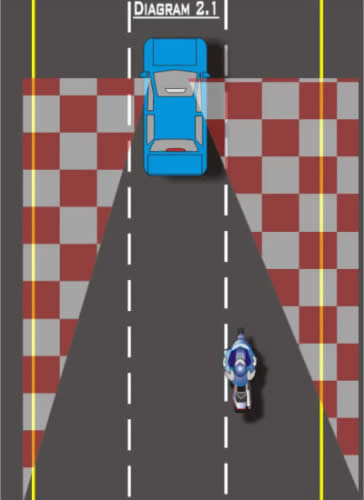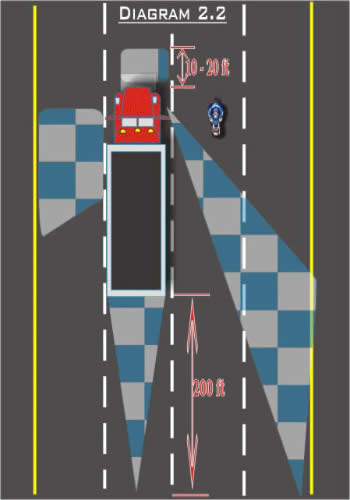Common Group Riding Terms
Pack: a number of motorcyclists who ride together, generally without maintaining fixed positions or distances between bikes. Packs are occasionally seen with 20-50 motorcyclists in a single formation.Group: a small number of motorcyclists who ride together maintaining a generally fixed distance between bikes and maintaining fixed positions within the formation (usually no more than six per group). On rides in which participation by a large number of motorcyclists occurs, it is common to have riders divided into several groups and to name them Group 1, Group 2, etc. This facilitates radio communication when several groups are listening to the same broadcasts and traffic coordination on the same CB channel.
Road Captain: a person who devises group riding rules or guidelines for a club or chapter of a motorcycling organization, who communicates these guidelines to the club, and who generally plans and lays out group rides. The Road Captain may or may not ride lead for a particular ride.
Lead Bike: a person who rides in the most forward position in a group and who relays information to all other riders in the group via hand signals and/or CB communications. The Lead Bike determines the group’s direction, speed, choice of lane, and formation. He or she often must make quick navigation decisions in the face of road hazards, changes in road surface conditions, poor signage, construction and other obstacles while maintaining control of his or her bike and communicating to those following. It is the responsibility of the Lead Bike to select a Tail Gunner with whom communications will be coordinated during a ride. If there are three groups on a ride, there will be three Lead Bikes.
Tail Gunner or Sweep: a person who rides in the last position in a group and who relays information to the Lead Bike regarding the other riders in the group, traffic patterns, equipment problems, etc. he or she observes. The TG must secure a lane for the rest of the group during lane changes into faster traffic (move first to block oncoming traffic) and close the door (move to block passing traffic) when a lane is lost in a merging lane situation. Usually this is the most experienced rider in a group, for the TG is the rider who stops to assist a rider who has mechanical trouble, loses control, or drops out of a ride for some other reason. The TG should be prepared to render aid to a downed or disabled rider in a group while communicating the problem to the Lead Bike and others in the group. If at all possible, the TG should be equipped with a CB and, could have a co-rider who can assist with communications or traffic control if a serious problem arises.
Cage: any vehicle that is not a motorcycle, but particularly an automobile.
Four-wheeler: any vehicle that is not a motorcycle except an 18-wheeler, a hack or a trike.
Group Parking: a formation in which all bikes in a group follow the Lead Bike in single file into a parking lot, making a U-turn such that they can all line up next to each other in the space available with the rear of their bikes against the curb or edge of the lot, the front tires pointing outward.
Parade formation: a formation in which all the motorcyclists in a group ride two abreast.
Single file: a formation in which all the motorcyclists in a group ride in one track of a lane.
Slot: any position within a group of riders in the right track of a lane, farthest from oncoming traffic.
Staggered formation: a formation of motorcyclists in a group in which the Lead Bike rides in the left track of a lane, the next bike in the right track or slot, and the next bike in the left track, and so on. Bikes in a group generally maintain a minimum interval of two seconds travel time between bikes in the same track, and one second travel time between each bike in the group. In a staggered formation, a rider still commands and may ride in the entire width of his lane as needed. Group riders may also ride single file or two abreast. The Tail Gunner may ride in the left or right track depending on the number of bikes in the group. It is preferable for the Tail Gunner to ride in the left track, so as to have the same visibility line as the Lead Bike.
Station keeping: maintaining a fixed position and interval within a group of riders but not riding as Lead Bike or Tail Gunner. Riders without a CB usually ride as station keepers in the middle of a group. Positions within a group are initially assigned by the Lead Bike based on the experience level of the rider, particularly his or her group riding experience.
Track: the zone of a lane in which a rider maintains his position in a group. A lane of traffic is divided into five zones: the left track is the second zone from the left, the middle of the lane (generally not used) is the third zone, and the right track is the fourth zone from the left. Two zones on the sides of a lane serve as margins. A rider may vary his path of travel from his normal track as is required by a road hazard or by an incursion into the group’s lane by other vehicles.
Two abreast: a formation in which the members of a group ride adjacent to each other in pairs, used when riding in parade formation. Used after stopping at signs and traffic signals so that riders can get through an intersection quickly and together if possible. When departing from a stop, the rider in the left track normally pulls out before the rider on the right, returning to a staggered formation.
Thank you to The Motorcycle Safety Group for this list of terms.

